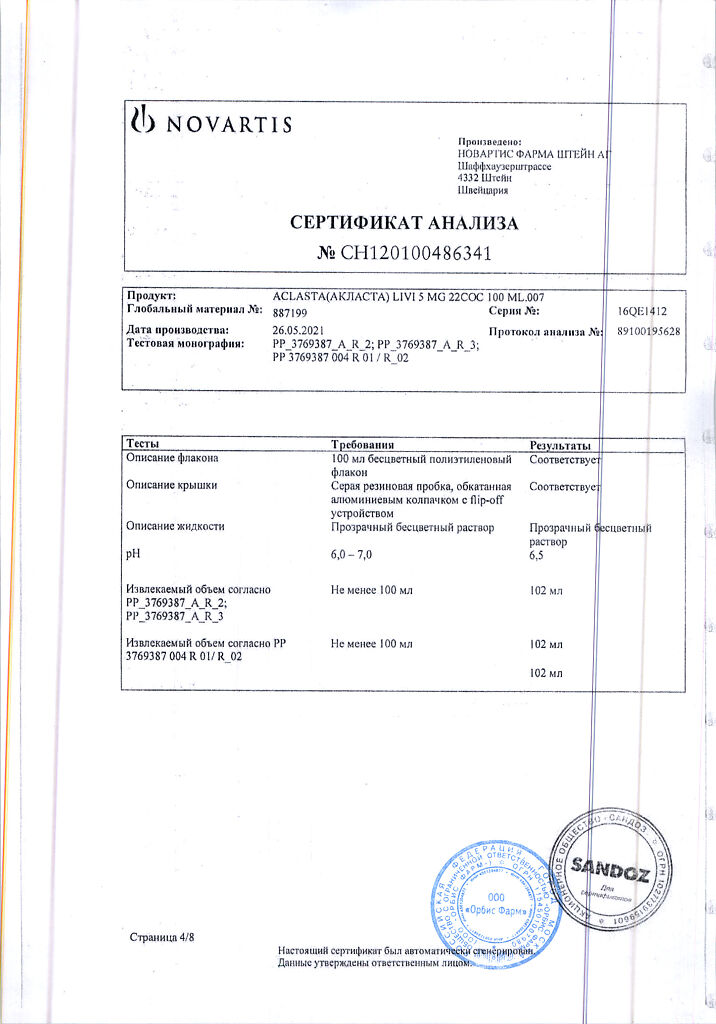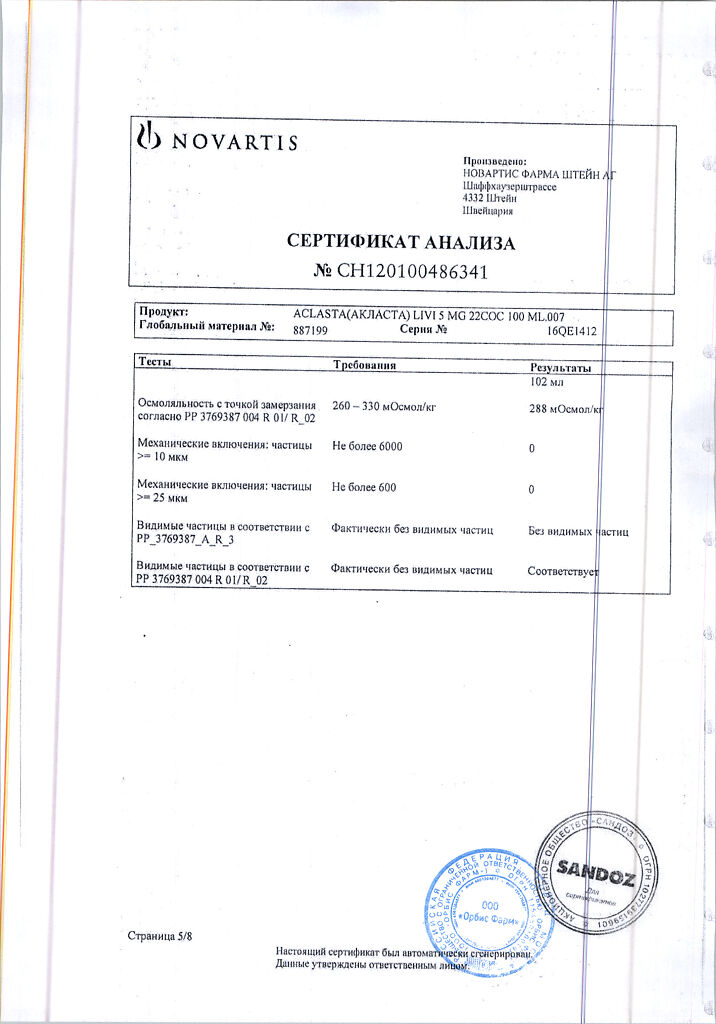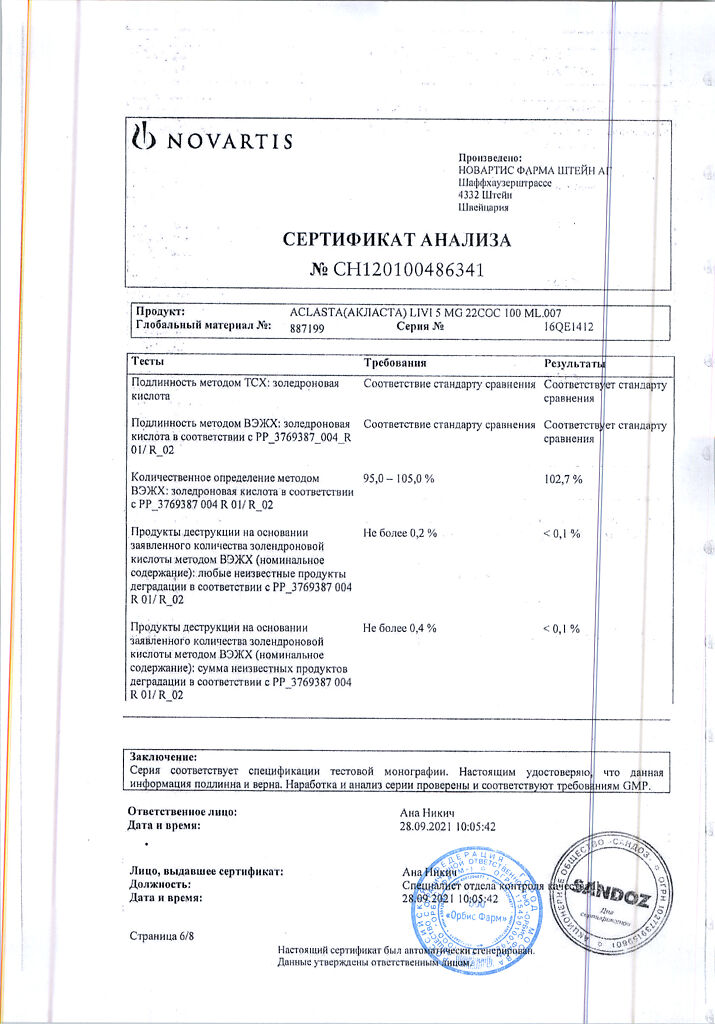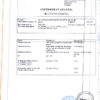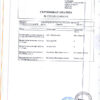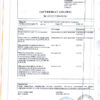No products in the cart.
Aclasta, 5 mg/100 ml 100 ml
€401.02 €347.55
Out of stock
(E-mail when Stock is available)
Description
Pharmacodynamics
Zoledronic acid, a member of the class of aminobisphosphonates, acts primarily on bone tissue, inhibits osteoclast activity and bone resorption. Selective action of bisphosphonates on bone tissue is based on high affinity for mineralized bone tissue.
After IV administration zoledronic acid rapidly redistributes into bone tissue and, like other bisphosphonates, localizes mainly in the sites of remodeling. The main molecular target of zoledronic acid in the osteoclast is the enzyme farnesyl pyrophosphate synthetase (FPS); however, other mechanisms of action of the drug are not excluded.
The prolonged period of action of the drug is determined by the high affinity to the active center of FPS and the expressed affinity to the mineralized bone tissue. On experimental models of accelerated osteoresorption it was shown that zoledronic acid significantly inhibits bone resorption without undesirable effect on formation, mineralization and mechanical properties of the bone tissue, reduces osteoclast activity and activation rate of new remodeling foci both in trabecular and cortical (Haversian) bone parts without causing formation of fibrous bone tissue and aberrant osteoid accumulation. Except for the high antiresorptive action, the effect of zoledronic acid on bone tissue is similar to that of other bisphosphonates.
The use of Aclasta in patients with postmenopausal osteoporosis (femoral neck bone mineral density T-criterion values of less than 2.5) showed a statistically significant 70% reduction in the risk of vertebral fractures by the end of the 3rd year of treatment, and a 60-70% reduction in the risk of one or more new/repeated fractures and moderate/severe vertebral fractures. In patients with osteoporosis aged 75 years and older, treatment with Aclasta achieved a 61% reduction in the risk of vertebral fractures.
Treatment with Aclasta reduced the relative risk of nonvertebral fractures of any localization, (including fractures of the phalanges and facial bones of the skull) by 33%. Administration of the drug for 3 years in patients with postmenopausal osteoporosis showed the increase of bone mineral density (BMD) of lumbar vertebrae, femur in general, femoral neck, and distal radius by 6.9; 6; 5, and 3.2% on the average respectively.
Aclast therapy for 1 year in patients with postmenopausal osteoporosis showed a decrease in the activity of bone ALP isoenzyme, N-terminal collagen propeptide type I (PINP) and β-C-terminal telopeptides of blood to the premenopausal value. No further decrease in the blood content of bone remodeling markers was noted with repeated injections of the drug for 3 years.
Application of Aclasta for 3 years significantly reduced the rate of growth loss in patients, and helped to shorten the period of immobilization in postmenopausal women with osteoporosis and vertebral fractures, including by reducing the intensity of pain syndrome.
Injection of the drug in patients (men and women) with fractures of the proximal femur (which occurred due to minimal trauma and required surgical intervention) resulted in a 35% reduction of the frequency of subsequent osteoporotic fractures of any localization compared to placebo (of which clinically significant vertebral fractures – by 46%, nonvertebral fractures – by 27%).
The relative risk of fatal outcomes (regardless of their cause) was reduced by 28% with the use of Aclasta in this category of patients. In patients with femoral fractures the use of Aclasta over 2 years showed 5.4% and 4.3% increase of MPC of femur in general and femoral neck region, respectively.
A once-daily use in men with primary (senile) or secondary (hypogonadism) osteoporosis showed a marked increase in MPC of lumbar vertebrae for 2 years.
In patients with GCS-induced osteoporosis, Aclasta also significantly increased BMD without adversely affecting bone structure and mineralization. When Aclasta was used once every 2 years to prevent postmenopausal osteoporosis in women with osteopenia and postmenopause duration of less and more than 5 years, a 6.3% and 5.4% increase in the lumbar spine BMD was observed, respectively. When the drug was administered once every 2 years, the MPC of the femur was increased by 4.7 and 3.2% in women with postmenopause duration of less than and more than 5 years, respectively.
In women with varying duration of postmenopause, administration of Aclasta once every 2 years resulted in a 44-46% reduction in blood β-C-terminal telopeptide concentrations (to premenopausal levels) and a 55-40% reduction in type I collagen N-terminal propeptide (PINP).
The treatment with Aclasta in patients with Paget’s bone disease showed statistically significant, rapid and prolonged therapeutic response, normalization of bone metabolism and plasma ALP activity.
The drug is also highly effective in patients previously treated with oral bisphosphonates.
It was found that in the majority of patients with zoledronic acid the therapeutic response is maintained throughout the entire period of treatment (about 2 years). Expressed decrease of pain syndrome at 6 months after a single injection of Aclasta in dose of 5 mg is comparable to analgesic effect of risedronic acid in dose of 30 mg/day.
In patients with postmenopausal osteoporosis and Paget’s disease zoledronic acid has no effect on the qualitative state of normal bone tissue, does not disturb bone remodeling and mineralization processes and helps to maintain normal trabecular bone architectonics.
Pharmacokinetics
Pharmacokinetic data were obtained after single and repeated 5- and 15-minute infusions of 2, 4, 8 and 16 mg zoledronic acid in 64 patients. The pharmacokinetic parameters were independent of the drug dose. After initiation of the drug, the plasma concentration of zoledronic acid increases rapidly, reaching a maximum at the end of the infusion.
After the end of infusion a rapid decrease of zoledronic acid concentration in plasma occurs (to the level of <10% of Cmax – after 4 hours and to <1% of Cmax – after 24 hours), then during long period low concentration of the preparation in plasma is maintained (not exceeding 0.1% of Cmax).
Zoledronic acid is excreted by kidneys in 3 phases: rapid biphasic excretion from the systemic blood stream with T1/2 of 0.24 h (α-phase) and 1.87 h (β-phase) and long phase with a final T1/2 of 146 h (γ-phase).
The rapid decrease of the drug concentration (α- and β-phase) in plasma is probably due to the rapid distribution of zoledronic acid in bone tissue and its excretion by the kidneys. No cumulation of the drug was observed with repeated injections every 28 days. Zoledronic acid is not metabolized and is excreted unchanged by the kidneys.
In the first 24 hours, (39±16)% of the administered dose is detected in the urine. The remaining amount of the drug is bound exclusively to the bone tissue, after which slow release of zoledronic acid back from the bone tissue into the systemic bloodstream and its excretion by the kidneys is observed. Total plasma clearance of the drug is (5.04±2.5) l/h and does not depend on the dose, sex, age, race and body weight of the patient.
The variability of zoledronic acid plasma clearance in the same patient and in different patients was found to be 36% and 34%, respectively. Increasing infusion time from 5 to 15 min leads to a 30% decrease in zoledronic acid concentration at the end of infusion, but does not affect the bioavailability of the drug. Binding of zoledronic acid to plasma proteins is low (43-55%) and does not depend on its concentration.
Pharmacokinetics in special clinical cases
Renal clearance of zoledronic acid correlates with creatinine Cl and is (75±33)% of creatinine Cl, with mean values of (84±29) ml/min (range, 22-143 ml/min) in 64 patients included in the pharmacokinetic study.
The slight increase in AUC (30-40%) in mild and moderate renal function impairment, compared with normal, and the absence of drug cumulation with repeated administration regardless of renal function, suggest that no dose adjustment of zoledronic acid is necessary in mild (creatinine Cl – 50-80 ml/min) and moderate (creatinine Cl – 30-50 ml/min) renal function impairment.
Indications
Indications
postmenopausal osteoporosis (to reduce the risk of femur, vertebral and extravertebral fractures; to increase bone mineral density);
prevention of new fractures in men and women with fractures of the proximal femur;
osteoporosis in men;
prevention and treatment of osteoporosis caused by the use of corticosteroids;
prevention of postmenopausal osteoporosis (in patients with osteopenia);
Paget’s disease of bone.
Pharmacological effect
Pharmacological effect
Pharmacodynamics
Zoledronic acid, a member of the aminobisphosphonate class, acts primarily on bone tissue, inhibiting osteoclast activity and bone resorption. The selective effect of bisphosphonates on bone tissue is based on their high affinity for mineralized bone tissue.
After intravenous administration, zoledronic acid is rapidly redistributed into bone tissue and, like other bisphosphonates, is localized primarily in areas of remodeling. The main molecular target of zoledronic acid in the osteoclast is the enzyme farnesyl pyrophosphate synthetase (FPS); However, the possibility of other mechanisms of action of the drug cannot be excluded.
The long period of action of the drug is determined by its high affinity for the active center of the FPS and pronounced affinity for mineralized bone tissue. Using experimental models of accelerated osteoresorption, it was shown that zoledronic acid significantly inhibits bone resorption without undesirable effects on the formation, mineralization and mechanical properties of bone tissue, dose-dependently reduces the activity of osteoclasts and the frequency of activation of new foci of remodeling in both the trabecular and cortical (Haversian) parts of the bone, without causing the formation of fibrous bone tissue and aberrant accumulation of osteoid. With the exception of its high antiresorptive effect, the effects of zoledronic acid on bone tissue are similar to those of other bisphosphonates.
When using Aklasta in patients with postmenopausal osteoporosis (T-criterion values for femoral neck bone mineral density less than 2.5), there was a statistically significant reduction in the risk of vertebral fractures by 70% by the end of the 3rd year of treatment, as well as a reduction in the risk of developing one or more new/repeated fractures and moderate/severe vertebral fractures by 60–70%. In patients with osteoporosis aged 75 years and older, treatment with Aklasta achieved a 61% reduction in the risk of developing vertebral fractures.
When treated with Aklasta, the relative risk of developing non-vertebral fractures of any location (including fractures of the phalanges of the fingers and bones of the facial part of the skull) decreased by 33%. When using the drug for 3 years in patients with postmenopausal osteoporosis, there was an increase in bone mineral density (BMD) of the lumbar vertebrae, the femur as a whole, in the area of the femoral neck and the distal radius by an average of 6.9; 6; 5 and 3.2% respectively.
During treatment with Aclasta for 1 year in patients with postmenopausal osteoporosis, a decrease in the activity of bone alkaline phosphatase isoenzyme, N-terminal propeptide of type I collagen (PINP) and β-C-terminal telopeptides of the blood to premenopausal values was observed. With repeated administrations of the drug over 3 years, no further decrease in the blood levels of markers of bone tissue remodeling was observed.
The use of Aklasta for 3 years significantly reduced the rate of height loss in patients, and also helped reduce the period of immobilization in postmenopausal women with osteoporosis and vertebral fractures, incl. by reducing the intensity of pain.
When the drug was administered to patients (men and women) with fractures of the proximal femur (arising as a result of minimal trauma and requiring surgical intervention), there was a decrease in the incidence of subsequent osteoporotic fractures of any location by 35% compared with placebo (of which clinically significant vertebral fractures – by 46%, non-vertebral fractures – by 27%).
When using Aklasta in this category of patients, the relative risk of deaths (regardless of their cause) decreased by 28%. In patients with femoral fractures, when using Aklasta for 2 years, there was an increase in BMD of the femur in general and in the femoral neck region by 5.4 and 4.3%, respectively.
When using the drug once a year in men with primary (senile) or secondary (hypogonadism) osteoporosis, a marked increase in BMD of the lumbar vertebrae was observed for 2 years.
In patients with osteoporosis caused by the use of corticosteroids, therapy with Aklasta also significantly increased BMD, without having a negative effect on bone tissue structure and mineralization. When using the drug Aklasta for the prevention of postmenopausal osteoporosis once every 2 years in women with osteopenia and a postmenopausal duration of less than and more than 5 years, an increase in BMD of the lumbar vertebrae was observed by 6.3 and 5.4%, respectively. When the drug was administered once every 2 years, femoral BMD increased by 4.7 and 3.2% in women with a postmenopausal duration of less than and more than 5 years, respectively.
In women with different durations of postmenopause, when administered with Aklasta once every 2 years, there was a decrease in the concentration of β-C-terminal telopeptides in the blood by 44–46% (to premenopausal levels) and N-terminal propeptide of type I collagen (PINP) by 55–40%.
When treating patients with Paget’s disease of bone with Aklasta, a statistically significant, rapid and long-term therapeutic response, normalization of bone metabolism and alkaline phosphatase activity in the blood plasma were observed.
The drug is also highly effective in patients previously treated with oral bisphosphonates.
It has been established that in the majority of patients using zoledronic acid, the therapeutic response persists throughout the entire treatment period (about 2 years). A pronounced reduction in pain at 6 months after a single administration of Aklasta at a dose of 5 mg is comparable to the analgesic effect of risedronic acid at a dose of 30 mg/day.
In patients with postmenopausal osteoporosis and Paget’s disease of bone, zoledronic acid does not affect the qualitative state of normal bone tissue, does not disrupt the processes of bone remodeling and mineralization, and promotes the preservation of normal trabecular bone architecture.
Pharmacokinetics
Pharmacokinetic data were obtained after single and repeated 5- and 15-minute infusions of 2, 4, 8 and 16 mg of zoledronic acid in 64 patients. Pharmacokinetic parameters do not depend on the dose of the drug. After the start of drug administration, the concentration of zoledronic acid in the blood plasma increases rapidly, reaching a maximum at the end of the infusion.
After the end of the infusion, there is a rapid decrease in the content of zoledronic acid in the blood plasma (to a level of <10% of Cmax - after 4 hours and to <1% of Cmax - after 24 hours), then for a long period a low concentration of the drug remains in the blood plasma (not exceeding 0.1% of Cmax).
Zoledronic acid is excreted by the kidneys in 3 stages: rapid biphasic elimination from the systemic circulation with T1/2 of 0.24 hours (α-phase) and 1.87 hours (β-phase) and a long phase with a final T1/2 of 146 hours (γ-phase).
The rapid decrease in the concentration of the drug (α- and β-phase) in the blood plasma is possibly due to the rapid distribution of zoledronic acid in bone tissue and its excretion by the kidneys. No accumulation of the drug was observed with repeated administrations every 28 days. Zoledronic acid is not metabolized and is excreted unchanged by the kidneys.
During the first 24 hours, (39±16)% of the administered dose is detected in the urine. The remaining amount of the drug binds exclusively to bone tissue, after which there is a slow release of zoledronic acid back from the bone tissue into the systemic circulation and its excretion by the kidneys. The total plasma clearance of the drug is (5.04 ± 2.5) l/h and does not depend on the dose, gender, age, race and body weight of the patient.
It was found that the variability of plasma clearance of zoledronic acid in the same patient and in different patients is 36 and 34%, respectively. Increasing the infusion time from 5 to 15 minutes leads to a decrease in the concentration of zoledronic acid by 30% at the end of the infusion, but does not affect the bioavailability of the drug. The binding of zoledronic acid to plasma proteins is low (43–55%) and does not depend on its concentration.
Pharmacokinetics in special clinical situations
Renal clearance of zoledronic acid correlates with creatinine Cl and is (75±33)% of creatinine Cl, the mean values of which were (84±29) ml/min (range: 22–143 ml/min) in 64 patients included in the pharmacokinetic study.
A slight increase in AUC (30–40%) in mild and moderate renal dysfunction compared to normal, and the absence of drug accumulation with repeated administration regardless of renal function, suggests that there is no need to adjust the dose of zoledronic acid in mild (creatinine clearance – 50-80 ml/min) and moderate (creatinine clearance – 30-50 ml/min) renal impairment.
Special instructions
Special instructions
The physician should inform patients about the main manifestations of hypocalcemia and ensure regular monitoring of patients at risk.
Therapy with Aklasta in patients with Paget’s disease of bone should be carried out only by qualified doctors with experience in treating this disease.
To reduce the frequency of some AEs observed within 3 days after administration of the drug, paracetamol or ibuprofen can be prescribed immediately after the infusion of Aklasta.
Zoledronic acid is the active ingredient of both Aklasta and Zometa (a drug for the treatment of cancer patients), however, these drugs are not interchangeable and should not be used simultaneously. In the presence of hypocalcemia, before starting the use of Aklasta, it is necessary to treat with adequate doses of calcium and vitamin D. You should also treat other existing disorders of mineral metabolism (for example, those occurring after operations on the thyroid and parathyroid glands, with hypoparathyroidism or decreased absorption of calcium in the intestine) and ensure regular monitoring of patients with hypocalcemia.
Renal dysfunction. To reduce the risk of developing kidney problems, follow these instructions:
Aklasta is not recommended for use in patients with severe impairment of nocturnal function (creatinine clearance less than 35 ml/min), since there is limited data on the safety of the drug in this category of patients.
Caution should be exercised when using Aklasta simultaneously with drugs that can have a significant effect on renal function.
Before administering the drug, it is necessary to determine the creatinine content in the blood plasma. During drug therapy in patients with a history of impaired renal function, a transient increase in plasma creatinine may be higher than in patients with normal renal function. When using the drug Aklasta in patients with risk factors for renal disorders, determination of creatinine content in the blood plasma should be carried out regularly.
Before administering Aklasta, ensure adequate hydration of the body. This is especially important for patients aged >65 years, as well as in patients receiving diuretic therapy.
The dose of the drug for a single intravenous infusion should not exceed 5 mg, and the administration of Aklasta should be carried out over at least 15 minutes.
Osteonecrosis of the jaw. Risk factors for the development of osteonecrosis are oncological diseases, concomitant therapy (for example, chemotherapy, radiation therapy, treatment with corticosteroids) and the presence of other concomitant diseases (for example, anemia, coagulopathies, infections, a history of dental diseases). Although the cause-and-effect relationship of osteonecrosis of the jaw with bisphosphonates has not been established, dental surgery should be avoided, since recovery time after these operations may be increased. Before starting treatment with bisphosphonates, it is necessary to conduct a dental examination and perform the necessary preventive procedures in advance in patients with risk factors (oncological diseases, chemotherapy, treatment with corticosteroids; poor oral hygiene). With the development of osteonecrosis of the jaw during bisphosphonate therapy, dental surgery may worsen the patient’s condition. There is no evidence that interrupting bisphosphonate treatment prior to dental procedures reduces the risk of osteonecrosis of the jaw. Treatment tactics for a particular patient should be based on an individual assessment of the risk/benefit ratio.
Influence on the ability to drive vehicles and operate machinery. There is no data on the effect of Aklasta on the ability to drive vehicles and operate machinery, however, due to the possibility of developing side effects (including blurred visual perception, lethargy, etc.), caution should be exercised when driving vehicles and operating machinery.
Active ingredient
Active ingredient
Zoledronic acid
Composition
Composition
1 bottle (100 ml) contains:
Active substance:
5 mg zoledronic acid monohydrate;
Excipients:
mannitol;
sodium citrate;
water for injections.
Pregnancy
Pregnancy
Aklasta is contraindicated during pregnancy and lactation (breastfeeding).
There are no data on the use of zoledronic acid in pregnant women.
Experimental studies have shown the presence of a teratogenic effect in one of the experimental rodent species.
The potential risk for use in humans is unknown.
Contraindications
Contraindications
hypersensitivity to zoledronic acid, other bisphosphonates and other components of Aklasta;
pregnancy;
lactation period (breastfeeding);
children and adolescents under 18 years of age (since the safety and effectiveness of Aklasta in this category of patients have not been studied);
severe disturbances of mineral metabolism, including hypocalcemia;
severe renal dysfunction (creatinine Cl less than 30 ml/min), because There is no sufficient clinical experience with the use of the drug in this category of patients.
Side Effects
Side Effects
Treatment of various types of osteoporosis, Paget’s disease of bone and prevention of new fractures in men and women with fractures of the proximal femur.
With intravenous administration of 5 mg of Aklasta once a year for the treatment of postmenopausal osteoporosis in women, osteoporosis in men, for the prevention of new fractures in men and women with fractures of the proximal femur, for the prevention and treatment of osteoporosis caused by the use of corticosteroids and for the treatment of Paget’s disease of bone, most adverse events (AEs) were mild or moderate.
After intravenous administration of the drug Aklasta, the following AEs were most often observed in these patients: usually lasting no more than 3 days (“post-dose” symptoms) – fever (18.1%), myalgia (9.4%), influenza-like syndrome (7.8%), arthralgia (6.8%), headache (6.5%). Most of the above-mentioned AEs observed within 3 days after drug administration were mild or moderate.
With repeated administration of the drug, the severity of these AEs decreased significantly. Below are AEs that may be associated (in the opinion of the treating physicians) with the use of the drug for the treatment of various types of osteoporosis, Paget’s disease of bone and for the prevention of new fractures in men and women with fractures of the proximal femur.
From the nervous system: often – headache, dizziness; sometimes – lethargy*, paresthesia, drowsiness, tremor, fainting.
From the senses: sometimes – conjunctivitis, eye pain, vertigo; rarely – uveitis*, episcleritis, iritis.
From the respiratory system: sometimes – shortness of breath*, cough.
From the digestive system: often – nausea, vomiting, diarrhea; sometimes – anorexia*, loss of appetite, dyspepsia*, abdominal pain*, dry mouth, esophagitis*, gastroesophageal reflux, pain in the upper abdomen, constipation.
From the skin and subcutaneous tissue: sometimes – rash, hyperhidrosis*, itching, erythema.
From the musculoskeletal system and connective tissue: often – arthralgia*, myalgia*; bone pain, pain in the back and limbs; sometimes – pain in the neck, swelling in the joints*, muscle spasms, pain in the shoulder girdle, pain in the chest* of musculoskeletal origin, muscle weakness, stiffness in the muscles* and joints*, arthritis, musculoskeletal pain.
From the urinary system: sometimes – increased blood creatinine levels, pollakiuria, proteinuria.
From the hematopoietic system: sometimes – anemia.
From the cardiovascular system: sometimes – increased blood pressure, sudden redness of the face.
Infections and infestations: sometimes – influenza, nasopharyngitis.
From the body as a whole: very often – increased temperature; often – flu-like syndrome, chills, increased fatigue*, asthenia, pain*, general malaise; Uncommon: peripheral edema, thirst*, increased excitability*, chest pain (not associated with heart disease).
*Note: in individual studies, the frequency of these AEs increased as follows: very often – myalgia, arthralgia, fatigue, pain; often – lethargy, shortness of breath, dyspepsia, esophagitis, abdominal pain, hyperhidrosis, muscle stiffness, swelling in the joints, pain in the chest area of musculoskeletal origin, stiffness in the joints, anorexia, thirst, increased excitability; infrequently – uveitis.
In separate studies, the following adverse events were recorded, the incidence of which in the Aclasta group was lower than in patients who did not receive the drug: redness of the eyes, increased levels of C-reactive protein, hypocalcemia, taste disturbances, toothache, gastritis, a feeling of palpitations, reactions at the injection site.
When using Aklasta in patients with postmenopausal osteoporosis, the overall incidence of atrial fibrillation during treatment with Aklasta was 2.5% (96 out of 3862 people) compared to 1.9% (75 out of 3852 patients) in patients not treated with the drug (placebo group). In 1.3% of patients (51 out of 3862 patients) receiving Aklasta, and in 0.6% (22 out of 3852 patients) in the placebo group, this adverse event was assessed as serious. The reason for the increased incidence of atrial fibrillation during therapy with Aclasta was not established in this study. The increased incidence of atrial fibrillation compared with placebo observed in this study was not found in other clinical studies of zoledronic acid.
Prevention of postmenopausal osteoporosis
When using the drug Aklasta for the prevention of postmenopausal osteoporosis (PMO), the overall safety profile of the drug was comparable to that in the treatment of PMO, with the exception of AEs that occurred within 3 days after infusion: pain, fever, chills, myalgia, nausea, headache, fatigue, arthralgia, the frequency of which was higher in women receiving the drug for the prevention of PMO. Most of these AEs were mild or moderate and resolved within 3 days of onset. With repeated administration of the drug, the severity of these AEs decreased significantly.
The following are AEs possibly associated with the use of the drug for the prevention of PMO (according to the attending physicians):
1) AEs that were observed more than once during the administration of Aklasta for the prevention of PMO and were not registered when using the drug for the treatment of various types of osteoporosis, Paget’s bone disease and for the prevention of new fractures in men and women with fractures of the proximal femur;
2) AEs, the frequency of which was higher in women receiving the drug to prevent PMO (compared to other categories of patients).
Mental disorders: sometimes – anxiety.
From the nervous system: very often – headache; often – tremor, lethargy; infrequently – decreased sensitivity, taste disturbances.
From the organ of vision: often – conjunctivitis, eye pain, iritis; infrequently – blurred vision.
From the digestive system: very often – nausea; often – anorexia, abdominal pain, pain in the upper abdomen, constipation.
From the skin and subcutaneous tissue: often – increased sweating at night.
From the musculoskeletal system and connective tissue: very often – myalgia; often – musculoskeletal pain, muscle spasm, pain in the chest area of musculoskeletal origin, pain in the jaw area, pain in the neck area; infrequently – pain in the side.
From the body as a whole and reactions at the site of drug administration: very often – pain, chills; often – peripheral edema, reactions at the injection site, non-cardiac pain in the chest area.
Changes in laboratory results
In patients with postmenopausal osteoporosis, while using Aklasta, in 0.2% of cases there was a decrease in calcium concentration (less than 1.87 mmol/l) in the blood serum; no clinical signs of hypocalcemia were observed.
When using the drug in patients with femoral fractures, osteoporosis in men and osteoporosis caused by taking corticosteroids, there was no decrease in the concentration of calcium in the blood plasma less than 1.87 mmol/l.
When using the drug in patients for the prevention of postmenopausal osteoporosis, there was no decrease in the concentration of calcium in the blood plasma less than 1.87 mmol/l. In patients with Paget’s disease, transient hypocalcemia accompanied by clinical manifestations was found in approximately 1% of cases.
Renal dysfunction. With intravenous administration of bisphosphonates, including zoledronic acid, there have been cases of renal dysfunction, manifested by an increase in blood creatinine concentrations and, in rare cases, acute renal failure. Impaired renal function with the use of zoledronic acid has been observed in patients with either a history of renal pathology or additional risk factors (for example, cancer requiring chemotherapy, use of nephrotoxic drugs, diuretics or severe dehydration). Most of these patients were treated with zoledronic acid at a dose of 4 mg every 3-4 weeks, but in some cases, renal dysfunction was observed after a single dose of zoledronic acid. When treated with Aklasta for 3 years in patients with postmenopausal osteoporosis, the incidence of increased plasma creatinine and the development of renal failure did not differ from that when using placebo. Patients receiving Aklasta were slightly more likely to experience a transient increase in blood creatinine concentrations within 10 days after infusion compared to placebo (1.8 and 0.8%, respectively).
When using Aklasta for 2 years in men with osteoporosis, the frequency of changes in creatinine clearance and the development of renal dysfunction was similar to that in the alendronic acid group.
In patients with osteoporosis caused by the use of corticosteroids, during therapy with Aklasta, the frequency of changes in creatinine clearance and the development of renal dysfunction was similar to that in the risedronic acid group.
Reactions at the injection site. When using Aklasta in patients with postmenopausal osteoporosis, redness, swelling and/or pain at the injection site were observed in 0.7% of cases.
In patients with femoral fractures, the incidence of reactions at the injection site was comparable to that in the placebo group. In the treatment of osteoporosis in men, the incidence of reactions at the injection site of Aclasta was 2.6% (compared to 1.4% in the alendronic acid group). In patients with osteoporosis caused by the use of corticosteroids, no reactions were observed at the injection site. When using the drug for the prevention of postmenopausal osteoporosis, the incidence of reactions at the injection site of Aklasta was 1.1% (compared to 2.0% in the placebo group).
Osteonecrosis of the jaw. Cases of osteonecrosis (most often of the jaw) occurred mainly in cancer patients receiving bisphosphonate treatment after tooth extraction or other dental procedures. Most patients had symptoms of a local infectious and inflammatory process, including osteomyelitis. In clinical studies in patients with osteoporosis, a case of osteonecrosis of the jaw occurred in 1 patient taking Aklasta and in 2 patients taking placebo. In all three cases, resolution of the process was noted. When using the drug Aklasta in patients with femoral fractures, with osteoporosis in men and osteoporosis caused by taking corticosteroids, as well as when using the drug for the prevention of postmenopausal osteoporosis, there were no cases of osteonecrosis of the jaw.
Isolated reports of adverse events
During therapy with Aklasta, the following AEs were observed in clinical practice without indication of a cause-and-effect relationship with the use of the drug (the frequency of AEs has not been established): hypersensitivity reactions, including in rare cases broncho-obstruction, urticaria, angioedema and isolated reports of the development of anaphylactic reactions, incl. anaphylactic shock. In rare cases, when using Aklasta in clinical practice, patients have experienced renal dysfunction, including renal failure requiring hemodialysis, especially in patients with a history of renal pathology or additional risk factors (for example, with concomitant therapy with nephrotoxic drugs, diuretics or severe dehydration).
In very rare cases, the following AEs have been reported: dehydration due to fever, vomiting and diarrhea occurring after administration of the drug; a pronounced decrease in blood pressure in patients with risk factors, osteonecrosis of the jaw, scleritis and inflammation in the orbital area.
Interaction
Interaction
No special studies have been conducted to study the interaction of zoledronic acid with other drugs. Zoledronic acid is not subject to systemic metabolism and does not affect human cytochrome P450 isoenzymes in vitro.
Zoledronic acid is characterized by a low degree of binding to plasma proteins (approximately 43–55%); interactions due to displacement of highly protein-bound drugs from binding sites are unlikely.
Zoledronic acid is excreted by the kidneys. Caution should be exercised when using Aklasta simultaneously with drugs that can have a significant effect on renal function (for example, aminoglycosides) and drugs that cause dehydration (for example, diuretics). In patients with impaired renal function, when using Aklasta together with drugs that are excreted primarily by the kidneys, it is possible to increase the systemic bioavailability of these drugs.
Pharmaceutical interactions and compatibility
Aklasta solution is incompatible with solutions containing calcium (for example, in one system for intravenous drip administration).
Overdose
Overdose
Currently, there is limited clinical data on cases of drug overdose. Patients who have received a dose of the drug that exceeds the recommended dose should be under medical supervision.
Symptoms: In acute overdose of zoledronic acid (limited data), renal dysfunction has been reported, including renal failure, hypocalcemia, hypophosphatemia, hypomagnesemia.
Treatment: in case of overdose of the drug, accompanied by clinical symptoms (numbness, tingling sensation, especially in the mouth, muscle spasms, etc.), intravenous administration of solutions containing calcium, magnesium and phosphate ions is indicated.
Storage conditions
Storage conditions
At a temperature not exceeding 25 °C
Shelf life
Shelf life
3 years
Manufacturer
Manufacturer
Fresenius Kabi Austria GmbH, Austria
Additional information
| Shelf life | 3 years |
|---|---|
| Conditions of storage | At a temperature not exceeding 25 °C |
| Manufacturer | Fresenius Kabi Austria GmbH, Austria |
| Medication form | solution for infusion |
| Brand | Fresenius Kabi Austria GmbH |
Related products
Buy Aclasta, 5 mg/100 ml 100 ml with delivery to USA, UK, Europe and over 120 other countries.


